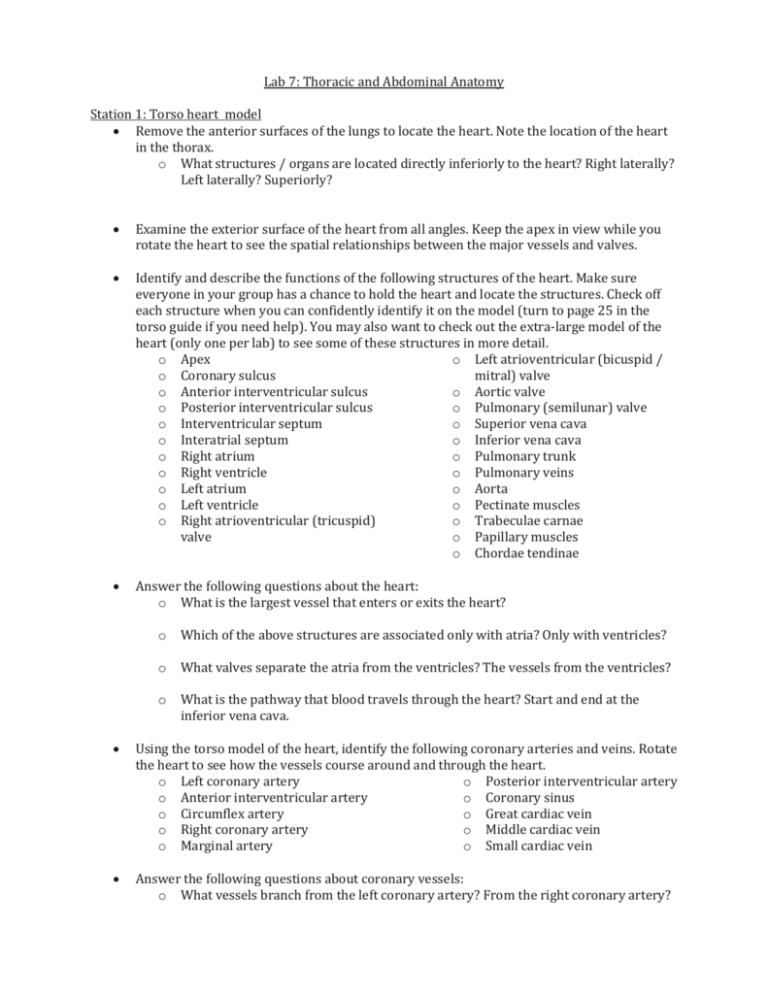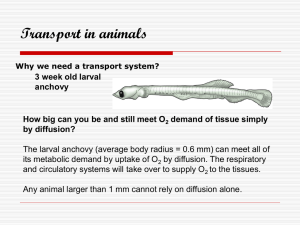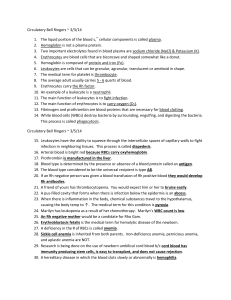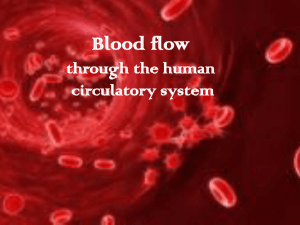Lab Guide - Sites@UCI
advertisement

Lab 7: Thoracic and Abdominal Anatomy Station 1: Torso heart model Remove the anterior surfaces of the lungs to locate the heart. Note the location of the heart in the thorax. o What structures / organs are located directly inferiorly to the heart? Right laterally? Left laterally? Superiorly? Examine the exterior surface of the heart from all angles. Keep the apex in view while you rotate the heart to see the spatial relationships between the major vessels and valves. Identify and describe the functions of the following structures of the heart. Make sure everyone in your group has a chance to hold the heart and locate the structures. Check off each structure when you can confidently identify it on the model (turn to page 25 in the torso guide if you need help). You may also want to check out the extra-large model of the heart (only one per lab) to see some of these structures in more detail. o Apex o Left atrioventricular (bicuspid / o Coronary sulcus mitral) valve o Anterior interventricular sulcus o Aortic valve o Posterior interventricular sulcus o Pulmonary (semilunar) valve o Interventricular septum o Superior vena cava o Interatrial septum o Inferior vena cava o Right atrium o Pulmonary trunk o Right ventricle o Pulmonary veins o Left atrium o Aorta o Left ventricle o Pectinate muscles o Right atrioventricular (tricuspid) o Trabeculae carnae valve o Papillary muscles o Chordae tendinae Answer the following questions about the heart: o What is the largest vessel that enters or exits the heart? o Which of the above structures are associated only with atria? Only with ventricles? o What valves separate the atria from the ventricles? The vessels from the ventricles? o What is the pathway that blood travels through the heart? Start and end at the inferior vena cava. Using the torso model of the heart, identify the following coronary arteries and veins. Rotate the heart to see how the vessels course around and through the heart. o Left coronary artery o Posterior interventricular artery o Anterior interventricular artery o Coronary sinus o Circumflex artery o Great cardiac vein o Right coronary artery o Middle cardiac vein o Marginal artery o Small cardiac vein Answer the following questions about coronary vessels: o What vessels branch from the left coronary artery? From the right coronary artery? o What sulcus does the great cardiac vein lie in? Remove all of the abdominal viscera from the human body torso. Examine the pathways that the major arteries and veins of the neck, thorax and abdomen take, and note how arteries and veins often travel together. What vessels can you identify? Write them down here. Station 2: Sheep heart dissection When you first remove your heart from the bag, you will see a lot of fatty tissue surrounding it. It is usually a waste of time to try to remove this tissue. The packaging and preserving process can cause the heart to be misshapen. If you are lucky, you will see that the ventral side of the heart has a couple of key features: 1) a large pulmonary trunk that extends off the top of it 2) the flaps of the auricles covering the top of the atria. 3) the curve of the entire front side, whereas the backside is much flatter. If you find the pulmonary artery, the aorta should be situated a little bit behind it. It may be covered by fat, so use your fingers to poke around until you find the opening. Push your finger all the way in and you will feel inside of the left ventricle. The left ventricle has a very thick wall, unlike the right ventricle. Insert your finger through the pulmonary artery to feel the outer wall of the right ventricle and you will notice and feel that it is much thinner than the left side of the heart. The two major veins that enter the heart can be found on the dorsal side, as both enter the atria. On the left side, you should be able to find the opening of the pulmonary vein as it enters the left atrium. The superior vena cava enters the right atrium. In many preserved hearts, the heart was cut at these points, so you won't see the vessels themselves, you will just find the openings. Again, use your fingers to feel around the heart to find the openings. Insert your scalpel into the superior vena cava and make an incision down through the wall of the right atrium and ventricle, as shown by the dotted line in the external heart picture. Pull the two sides apart and look for the tricuspid valve between the right atrium and the right ventricle. The membranes are connected to flaps of muscle called the papillary muscles by tendons called the chordae tendinae. Insert your probe into the pulmonary artery and see it come through to the right ventricle. Make an incision down through this artery and look inside it for three small membranous pockets. These form the pulmonary semilunar valve. Insert your dissecting scissors or scalpel into the left auricle at the base of the aorta and make an incision down through the wall of the left atrium and ventricle, as shown by the dotted line in the external heart picture. Locate the mitral / bicuspid valve between the left atrium and ventricle. Insert a probe into the aorta and observe where it connects to the left ventricle. Make an incision up through the aorta and examine the inside carefully for three small membranous pockets. These form the aortic semilunar valve. Answer the following questions about the heart: o Which is thicker, the arteries or veins? o Does the right ventricle have less volume to hold blood compared to the left ventricle? o Hold the heart with the apex toward you and the dorsal surface facing down, and sketch the locations of the four main arteries in the space below. Station 3: Major arteries and veins of the body, Human Skeleton Using a skeleton, map out the locations of these arteries and veins. Test your partner (and other group members) by pointing to different transverse sections of limbs, torso, and abdomen and describe which arteries and veins are present. Arteries o Ascending aorta o Aortic arch o Descending aorta o Brachiocephalic trunk o Common carotid arteries o External carotid arteries o Internal carotid arteries o Subclavian arteries o Axillary artery o Brachial artery o o o o o o o o o o o Ulnar artery Radial artery Palmar arches Thoracic aorta Celiac trunk Superior mesenteric artery Inferior mesenteric artery Renal artery Gonadal artery Common iliac arteries Internal iliac arteries o o o o o o Veins o o o o o o o o o o o External iliac arteries Femoral artery Popliteal artery Anterior tibial artery Posterior tibial artery Arcuate artery Superior vena cava Inferior vena cava Brachiocephalic veins Internal jugular vein External jugular vein Dural venous sinuses Subclavian vein Axillary vein Cephalic vein Brachial vein Basilic vein o o o o o o o o o o o o o o o o o o Median cubital vein Ulnar vein Radial vein Dorsal venous network Hepatic veins Splenic vein Hepatic portal vein Renal vein Superior mesenteric vein Inferior mesenteric vein Common iliac vein Internal iliac vein External iliac vein Femoral vein Great saphenous vein Popliteal vein Posterior tibial vein Dorsal venous arch Answer the following questions about systemic arteries and veins: o What vessels does blood travel through from the left ventricle to the left pinky finger? o What vessels does blood travel through from the right pinky toe to the right atrium? Station 4: Thoracic and abdomianl organs, Torso Replace all of the viscera back into the torso, including the anterior coverings of the lungs. Examine the exterior portions of the lungs, and then remove them. Examine the interior portions of the lungs. Identify and describe the functions of the following structures of the respiratory system. Check off each structure when you can confidently identify it on the model (turn to page 24 in the torso guide if you need help). o Trachea o Inferior pulmonary lobe (right o Thyroid cartilage and left) o Cricoid cartilage o Middle pulmonary lobe (right) o Primary bronchus o Horizontal fissure of right o Superior pulmonary lobe lung (right and left) o Apex of lung o Oblique fissure (right and left) Answer the following questions about the respiratory system: o Why are there two lobes in the left lung but three lobes in the right lung? o What is the difference between thyroid cartilage and cricoid cartilage? Abdominopelvic organs and locations . Using colored tape, make the four planes that create the nine regions of the anterior abdominal wall. What are the names of the four planes that form these regions? What are the names of the nine regions? Consider the following organs. What regions are they located in? (they can be in more than one region) o Stomach o Liver o Gallbladder o Transverse colon o Ascending colon o Descending colon o Pancreas o Sigmoid colon o Cecum o Rectum o Urinary bladder o Kidney Digestive system Remove colored tape. Examine the anterior aspect of the abdominal wall. What organs can you identify? Label the structures of the digestive organs in the abdominopelvic cavity with tape or small squares of index card. You may need to remove the organs and rotate them to identify all of the structures. Check off each structure once you have confidently identified it. Use the Torso Guide Book (pages 1, 14, 26, and 28) if you need assistance. o Greater curvature Mouth o Lesser curvature Palate Small intestine Tongue o Duodenum Teeth o Jejunum Parotid gland o Ileum Submandibular gland Sublingual gland Large intestine Oropharynx o Cecum Laryngopharnyx o Ileocecal valve Esophagus o Ascending colon Stomach o Transverse colon o Cardia o Descending colon o Fundus o Sigmoid colon o Body o Rectum o Pylorus Greater omentum Liver o Right lobe o Left lobe o Right and left hepatic ducts o Common hepatic duct o Common hepatic artery o Hepatic portal vein o Hepatic veins Gallbladder o Cystic duct o Bile duct Pancreas o Pancreatic duct Show your instructor your labeled torso and digestive organs before moving on. Answer the following questions about the digestive system: o What is the order that food travels through the digestive system? Name all organs (and sub-structures) and valves / sphincters. o What is the function of the villi and microvilli in the small intestine? o What part of the small intestine does the liver, pancreas, and gallbladder deposit substances into? What is the name of this opening? Urinary system Remove all of the organs so that you can examine the kidneys, ureters, and bladder. Identify the structures of the urinary system organs and structures. Check off each structure once you have confidently identified it. Use the Torso Guide Book (page 1). o Minor and major calices Kidney o Renal artery o Hilium o Renal vein o Fibrous capsule o Renal cortex Ureter o Renal medulla Bladder o Renal pyramids o Trigone o Renal columns o Renal pelvis Answer the following questions about the urinary system: o What nephron structures are found in the renal cortex? In the renal medulla? o How are the ureters similar and/or different between males and females? o What structures does urine pass through in order to exit the body? Start with the location of urine production and end where the urine leaves the body. Station 5: Reproductive system models Go to the station that has the models of the male and female reproductive organs. Identify the structures of the male and female reproductive system organs and structures. Check off each structure once you have confidently identified it. Male reproductive system o Penis Female reproductive system Glans o Labia majora Corpus spongiosum o Labia minora Corpora cavernosa o Clitoris o Scrotum o Vagina o Testes o Utrerus o Seminiferous tubules o Cervix o Epididymis o Cervical canal o Ductus (vas) deferens o Uterine (Fallopian) tubes o Seminal vesicles Fimbrae o Prostate gland o Ovary o Ejaculatory duct Answer the following questions about the reproductive system: o What male and female reproductive organs are analogous to each other? o What are the functions of fimbrae in the female reproductive system? o If a sperm is to fertilize an egg, what is the path that sperm travels, starting from the seminiferous tubules and ending at the location of fertilization? PAL Resources Be familiar with the following resources in both the cadaver and anatomical models sections for your next PAL quiz: Cardiovascular system Respiratory system Digestive system Urinary system Reproductive system









